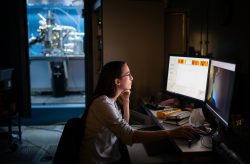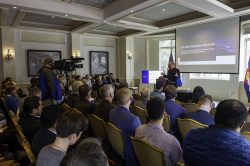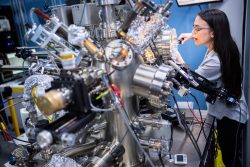ALBUQUERQUE, N.M. — They knew it was an ambitious goal. But by the time they announced it in 2022, Sandia National Laboratories and The University of New Mexico — two of the state’s largest research institutions — had been working out their strategy for more than a year.

Their goal: transform the state into a global powerhouse in the emerging quantum technology market. Success would mean the arrival of tech companies and startups, jobs and investments — an economic resurgence for the southwestern state.
The plan is picking up steam.
In January, Sandia and UNM created the Quantum New Mexico Institute, a cooperatively run research center headquartered at the university. This marks a major milestone in the comprehensive strategy to advance research, court businesses and train a quantum-ready workforce.
“Our vision is to make New Mexico a destination for quantum companies and scientists across the world,” said Setso Metodi, institute co-director and Sandia manager of quantum computer science.
All quantum roads lead to Albuquerque
The plan started taking shape in 2021. Sandia’s deputy chief research officer, Basil Hassan, and UNM’s provost and executive vice president for academic affairs, James Holloway, launched a “road map” of large collaborative partnerships for the two institutions.
“We challenged our teams to come up with a plan to forge more powerful and impactful partnerships,” Hassan said. “An obvious area that leveraged the strengths of both institutions was quantum information science.”
The road map their teams drew up laid out the Quantum New Mexico Institute as the foundation for joint New Mexico-wide engagement with the state’s other research institutions.
By 2022, its architects had already gathered a coalition of supporters. They publicly announced their plans at a gathering of science, education and economic development leaders dedicated to bringing a quantum economy to the state.
But research was only one part of a larger plan. Regional and national partnerships were marked out to cement into place the plan’s two other pillars: industry engagement and workforce development.
In essence, the two institutions were forming a plan to ensure all quantum roads lead to Albuquerque.

The Mountain West has seen a flurry of coalitions forming among labs, universities and companies in recent years. Many of these were spurred by the National Quantum Initiative Act, signed in 2018 by President Donald Trump. The legislation opened a floodgate of federal funding for quantum research but required many of the recipients to be organized into research hubs.
Within many of them, Sandia is providing leadership and representing New Mexico. Sandia participates in regional coalitions, including Elevate Quantum, a Colorado-based nonprofit consortium focused on creating jobs, training workers and launching startups across the quantum ecosystem; Q-SEnSE (an acronym for Quantum Systems through Entangled Science and Engineering), led by the University of Colorado; and the Quantum Collaborative out of Arizona State University.
Nationally, it is a leading partner in the Quantum Systems Accelerator, a Department of Energy research center led by Berkeley National Laboratory in California and leads workforce development strategy in the Quantum Economic Development Consortium in Arlington, Virginia.
Named a Designated TechHub by the U.S. Department of Commerce Economic Development Administration, Elevate Quantum is made up of more than 85 organizations across the Mountain West region.
“The quantum assets in the New Mexico region are already world class — but the state’s investments in the Quantum New Mexico Institute and partnership with Elevate Quantum will help cement the global leadership role of the state, the wider Mountain West and America for decades to come,” said Zachary Yerushalmi, CEO of Elevate Quantum.
Sandia is working with its partners there to put together a bid that would bring nearly $12 million in federal assistance to New Mexico. The funding would allow Sandia and UNM to build collaborative lab spaces to share with local startups and create a first-of-its-kind training program for quantum technicians at community colleges.
Additionally, Sandia has created the Gil Herrera Fellowship in Quantum Information Science, a highly selective postdoctoral research fellowship that is helping foster stronger partnerships with universities.
Institute accelerates creation of a quantum-ready workforce
The Quantum New Mexico Institute expands Sandia and UNM’s ability to train a quantum-savvy workforce.
“A strong, local talent pool is a key selling point for companies thinking about doing business here,” said Sandia technical business development specialist Jake Douglass.

Significantly, according to the university, UNM has already granted 40 doctorates in physics to individuals who have gone on to become leaders in quantum information science. With the new research center, organizers expect that number to grow, along with the state’s influence in the emerging tech market.
“New Mexico’s role in the development of quantum information science will be vital to the technology of tomorrow,” said Ivan Deutsch, UNM distinguished professor and founding director of the Quantum New Mexico Institute.
The institute will also be an avenue to provide underserved communities more opportunities to learn about quantum science. It will be able to build on programs like the Quantum, Computing, Mathematics, and Physics high school summer camp and UNM’s undergraduate QuREACH program.
For decades, New Mexico has been a steady source of breakthroughs in quantum science, Hassan said. Sandia is already a global authority on benchmarking quantum systems. It also is a leader in designing and manufacturing ion traps, a key component for certain quantum computers. However, New Mexico has lacked the kind of statewide partnerships that exist elsewhere, he said. The new institute is designed to fill this gap.
“If we succeed in creating long-standing, permanent partnerships between universities and national labs, we will become national leaders,” Metodi said.
Hassan added, “Dissolving barriers to collaboration and expanding the institute to include more organizations will be key to our future success.”
What is quantum information science?
Quantum information science is a combination of physics, chemistry, computer science, math and engineering. People in this field harness quantum mechanics to build revolutionary new technologies, including quantum computers and many other new kinds of sensors, materials, scientific instruments, communications systems and atomic clocks.
However, the tech field is still relatively young. Quantum computers exist, but nations and companies are still racing to build one that can outperform a conventional computer at a useful task. The potential rewards are generally expected to be great.
“As a national laboratory, Sandia Labs is responsible for understanding applications of quantum technology to national security and how it can enrich society,” Hassan said. “Sandia is strategically looking at how to leverage its internal research and development funds and leverage academic partnerships to have a major impact in this technology area.”
According to Metodi, the newness of quantum computing is a large reason why people are attracted to work in it.
“It is still fundamentally an unsolved physics problem,” he said.